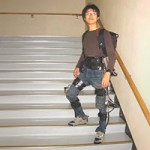Archive for 2003
Design and control of an exoskeleton system for human upper-limb motion assist
- Тип контента: Научная статья
- Номер документа: 393
- Название документа: Design and control of an exoskeleton system for human upper-limb motion assist
- Номер (DOI, IBSN, Патент): 10.1109/AIM.2003.1225466
- Изобретатель/автор: Watanabe, K., Tanaka, T., Kiguchi, K., Fukuda, T.
- Правопреемник/учебное заведение: Dept. of Adv. Syst. Control Eng., Saga Univ., Japan
- Дата публикации документа: 2003-09-04
- Страна опубликовавшая документ: Япония
- Язык документа: Английский
- Наименование изделия: Не заполнено
- Источник: http://ieeexplore.ieee.org/search/freesrchabstract.jsp?tp=&a
- Вложения: Да
- Аналитик: Дмитрий Соловьев
 In this paper; we introduce a 3-DOF exoskeleton system to assist the human upper-limb motion (shoulder flexion-extension motion, shoulder adduction-abduction motion, and elbow flexion-extension motion) for daily activity and rehabilitation. The electromyogram (EMG) signals of human muscles are important signals to understand how the patient intends to move. The proposed exoskeleton automatically assists the patient ‘s motion for daily activity and rehabilitation mainly based on the skin surface EMG signals. Even though the EMG signals contain very important information, however, it is not very easy to predict the patient upper-limb motion (elbow and shoulder motion) based on the EMG signals in a short time because of the difficulty in using the EMG signals as the controller input signals. In order to cope with this problem, fuzzy-neuro control has been applied to realize the sophisticated real-time control of the exoskeleton system for motion assist of the patient. Experiment has been performed to evaluate the proposed exoskeleton and its control system.
In this paper; we introduce a 3-DOF exoskeleton system to assist the human upper-limb motion (shoulder flexion-extension motion, shoulder adduction-abduction motion, and elbow flexion-extension motion) for daily activity and rehabilitation. The electromyogram (EMG) signals of human muscles are important signals to understand how the patient intends to move. The proposed exoskeleton automatically assists the patient ‘s motion for daily activity and rehabilitation mainly based on the skin surface EMG signals. Even though the EMG signals contain very important information, however, it is not very easy to predict the patient upper-limb motion (elbow and shoulder motion) based on the EMG signals in a short time because of the difficulty in using the EMG signals as the controller input signals. In order to cope with this problem, fuzzy-neuro control has been applied to realize the sophisticated real-time control of the exoskeleton system for motion assist of the patient. Experiment has been performed to evaluate the proposed exoskeleton and its control system.
Категория: Научные статьи | Нет комментариев »
Morphological dominant points detection for motion analysis on programmable retina
- Тип контента: Научная статья
- Номер документа: 1494
- Название документа: Morphological dominant points detection for motion analysis on programmable retina
- Номер (DOI, IBSN, Патент): 10.1109/ISSPA.2003.1224959
- Изобретатель/автор: Richefeu, J.
- Правопреемник/учебное заведение: Unite d'Electronique et d'Informatique, Ecole Nat. Sup. de Tech. Avancees, Paris, France
- Дата публикации документа: 2003-08-26
- Страна опубликовавшая документ: Франция
- Язык документа: Английский
- Наименование изделия: Не заполнено
- Источник: http://ieeexplore.ieee.org/search/freesrchabstract.jsp?tp=&a
- Вложения: Да
- Аналитик: Дмитрий Соловьев
 This paper presents the first results of my PhD thesis, which addresses the problem dominant points detection for motion analysis on programmable retina. The goal of this research is to develop new algorithmical concepts to implement efficient image processing tools over the massively parallel cellular array of processors of the programmable retina, in order to perform effective motion analysis tasks.
This paper presents the first results of my PhD thesis, which addresses the problem dominant points detection for motion analysis on programmable retina. The goal of this research is to develop new algorithmical concepts to implement efficient image processing tools over the massively parallel cellular array of processors of the programmable retina, in order to perform effective motion analysis tasks.
Категория: Научные статьи | Нет комментариев »
Изобретён робототехнический костюм для больных и пожилых людей
- Тип контента: Новостная статья
- Номер документа: 1984
- Название документа: Изобретён робототехнический костюм для больных и пожилых людей
- Номер (DOI, IBSN, Патент): Не заполнено
- Изобретатель/автор: Не заполнено
- Правопреемник/учебное заведение: Не заполнено
- Дата публикации документа: 2003-08-21
- Страна опубликовавшая документ: Россия
- Язык документа: Русский
- Наименование изделия: Не заполнено
- Источник: http://www.membrana.ru/particle/5738
- Вложения: Не заполнено
- Аналитик: Ридна Украина)))
 Японский профессор Ёшиюки Санкай (Yoshiyuki Sankai) из университета Цукуба (Universtiy of Tsukuba) разработал для пожилых и больных людей робототехнический костюм HAL (Hybrid Assistive Leg — гибридная поддерживающая опора).
Японский профессор Ёшиюки Санкай (Yoshiyuki Sankai) из университета Цукуба (Universtiy of Tsukuba) разработал для пожилых и больных людей робототехнический костюм HAL (Hybrid Assistive Leg — гибридная поддерживающая опора).
Категория: HAL 3 | Нет комментариев »
Tendon-driven serial distal mechanism
- Тип контента: Патент
- Номер документа: 4447
- Название документа: Tendon-driven serial distal mechanism
- Номер (DOI, IBSN, Патент): US006593907B1
- Изобретатель/автор: Demers J.-G., Boelen B.M.A.
- Правопреемник/учебное заведение: MPB Technologies Inc., Pointe Claire, CA, USA
- Дата публикации документа: 2003-07-15
- Страна опубликовавшая документ: США
- Язык документа: Английский
- Наименование изделия: Не заполнено
- Источник: http://www.google.com/patents/US6593907
- Вложения: Да
- Аналитик: Дмитрий Соловьев
 A distal mechanism for providing three degrees of freedom for a rotating handle. Three stages provide a serial mechanical linkage between a handle and a platform, which may itself be moveable in three degrees of freedom. Each stage has an axis of rotation, and the three axes intersect. The first stage is mounted to the platform in such a way as to provide rotation about the first stage axis. The first stage carries the second, allowing the second stage to rotate about its axis. The second stage carries the third stage, allowing the third stage to rotate about its axis. The third stage is fixed to the handle, and the third stage axis passes along the length of the handle. Each stage has a sensor to measure its rotation, and a tendon means of transferring torque from a remote motor to torque about the rotation axis of the respective stage. The sensors have two limited angle ranges of measurement, about 110 degrees wide and on opposite sides of the rotation. The third stage has an auxiliary sensor, mounted in quadrature to the main third stage sensor. It is connected to an idler that carries the third stage tendon. The auxiliary third stage sensor measures angles of rotation that are not measured by the main third stage sensor. The two third stage sensors together provide continuous roll measurement about the third stage axis.
A distal mechanism for providing three degrees of freedom for a rotating handle. Three stages provide a serial mechanical linkage between a handle and a platform, which may itself be moveable in three degrees of freedom. Each stage has an axis of rotation, and the three axes intersect. The first stage is mounted to the platform in such a way as to provide rotation about the first stage axis. The first stage carries the second, allowing the second stage to rotate about its axis. The second stage carries the third stage, allowing the third stage to rotate about its axis. The third stage is fixed to the handle, and the third stage axis passes along the length of the handle. Each stage has a sensor to measure its rotation, and a tendon means of transferring torque from a remote motor to torque about the rotation axis of the respective stage. The sensors have two limited angle ranges of measurement, about 110 degrees wide and on opposite sides of the rotation. The third stage has an auxiliary sensor, mounted in quadrature to the main third stage sensor. It is connected to an idler that carries the third stage tendon. The auxiliary third stage sensor measures angles of rotation that are not measured by the main third stage sensor. The two third stage sensors together provide continuous roll measurement about the third stage axis.
Категория: Патенты | Нет комментариев »
A new exoskeleton-type masterarm with force reflection based on the torque sensor beam
- Тип контента: Научная статья
- Номер документа: 751
- Название документа: A new exoskeleton-type masterarm with force reflection based on the torque sensor beam
- Номер (DOI, IBSN, Патент): 10.1109/ROBOT.2001.933019
- Изобретатель/автор: Yoon Sang Kim, Sooyong Lee, Munsang Kim, Chong-Won Lee, Changhyun Cho
- Правопреемник/учебное заведение: Dept. of Electr. Eng., Washington Univ., Seattle, WA, USA
- Дата публикации документа: 2003-07-09
- Страна опубликовавшая документ: США
- Язык документа: Английский
- Наименование изделия: Не заполнено
- Источник: http://ieeexplore.ieee.org/search/freesrchabstract.jsp?tp=&a
- Вложения: Да
- Аналитик: Дмитрий Соловьев
 A new concept of the exoskeleton-type masterarm, composed of serial links, is introduced in the paper. To provide maximum range of human motion, several redundant joints are added to the serial links. In order to reduce the number of joints to be measured, kinematics of serial links was taken into consideration in design. Three measurable, controllable joints and three redundant free joints are used for the upper arm (shoulder), similarly to the forearm (wrist) while one measurable, controllable joint is used for the elbow. In particular, a torque sensor beam is designed for fine force reflection using the strain gauge. It detects the torque as well as its direction applied by the human operator, which allows the electric brake to be used as an actuator for force reflection. The electric brake constrains the joint movement so that the operator can feel the force. This electric brake outperforms the motor in terms of torque/weight ratio and makes the device light and compact. This masterarm measures the movement of the operator’s arm precisely, and its can be used for teleoperation with a slave robot, or as a motion planner for an industrial robot.
A new concept of the exoskeleton-type masterarm, composed of serial links, is introduced in the paper. To provide maximum range of human motion, several redundant joints are added to the serial links. In order to reduce the number of joints to be measured, kinematics of serial links was taken into consideration in design. Three measurable, controllable joints and three redundant free joints are used for the upper arm (shoulder), similarly to the forearm (wrist) while one measurable, controllable joint is used for the elbow. In particular, a torque sensor beam is designed for fine force reflection using the strain gauge. It detects the torque as well as its direction applied by the human operator, which allows the electric brake to be used as an actuator for force reflection. The electric brake constrains the joint movement so that the operator can feel the force. This electric brake outperforms the motor in terms of torque/weight ratio and makes the device light and compact. This masterarm measures the movement of the operator’s arm precisely, and its can be used for teleoperation with a slave robot, or as a motion planner for an industrial robot.
Категория: Научные статьи | Нет комментариев »
Статистика
Категорий: 179
Статей всего: 2,003
По типу:
Видео: 36
Выдержка с форума: 1
Контактные данные: 12
Научная статья: 1388
Не заполнено: 5
Новостная статья: 317
Обзор технологии: 42
Патент: 219
Тех.подробности: 34
Тип: 1
Комментариев: 9,102
Изображений: 3,005
Подробней...
ТОР 10 аналитиков
-
Глаголева Елена - 591
Дмитрий Соловьев - 459
Helix - 218
Ридна Украина))) - 85
Наталья Черкасова - 81
max-orduan - 29
Елена Токай - 15
Роман Михайлов - 9
Мансур Жигануров - 4
Дуванова Татьяна - 3
Календарь
| Пн | Вт | Ср | Чт | Пт | Сб | Вс |
|---|---|---|---|---|---|---|
| « Ноя | ||||||
| 1 | 2 | 3 | 4 | 5 | 6 | 7 |
| 8 | 9 | 10 | 11 | 12 | 13 | 14 |
| 15 | 16 | 17 | 18 | 19 | 20 | 21 |
| 22 | 23 | 24 | 25 | 26 | 27 | 28 |
| 29 | 30 | 31 | ||||
Авторизация
Ошибка в тексте?
Выдели её мышкой!
И нажми Ctrl+Enter